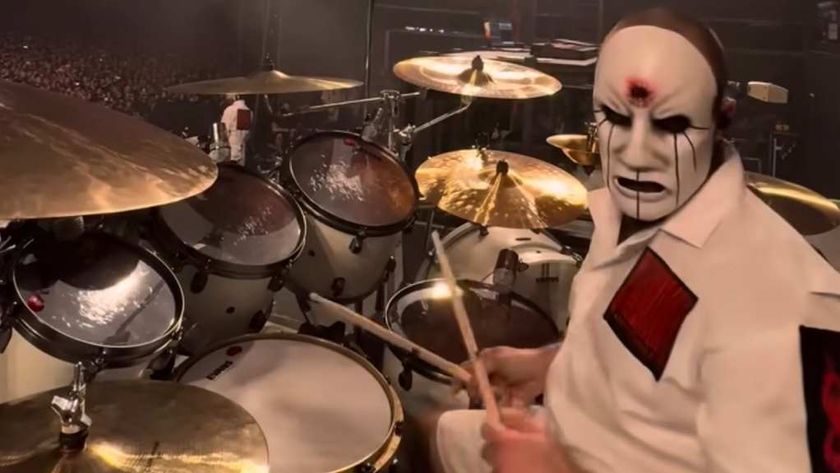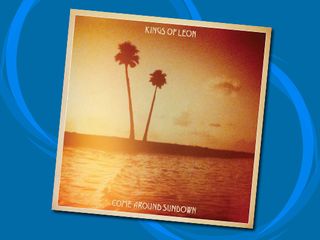
Introduction
Kings Of Leon's Come Around Sundown (2010) is the band's fifth studio album, and the follow-up to the worldwide smash, Only By The Night. Read on for our track-by-track review of the Followill's new album...
First impressions of a new record can be tricky, especially when it's by a band coming off an artistic high. Have previous marks been hit? Has new ground been broken? And most importantly, if the group is indeed going somewhere new, are their footsteps ones we want to follow?
A maiden spin of Kings Of Leon's Come Around Sundown reveals a wealth of aural surprises, many of them confounding but all enthralling. Past producers Angelo Petraglia and Jacquire King are credited as boardsmen here, but the fingerprints could have been David Lynch's, because, much like Blue Velvet and Mulholland Dr, this is a difficult work to comprehend - and impossible to shake.
With 2003’s Youth & Young Manhood, KOL were pegged as red-headed stepchildren to The Strokes - the ‘Southern Strokes’ they were even called - a gang of horny hicks escaping their Pentecostal past and glomming onto the de rigueur life of wine, women and song. Their hayseed backstory and quasi-garage rock seemed somehow novel and provided the narrative for critics to romanticize them.
Musically, they progressed wobbly at first, gradually taking on an experimental approach before going warp-speed with the atmospherics on the anthem-heavy juggernaut Only By The Night, which only earned them a new tag - the ‘Southern U2' (talk about your 800-pound gorillas!). This latter description, however, is more apt, for the Nashville-based quartet are now confidently, brazenly strutting down the same corridor of sonic exploration where those four Irish upstarts once stood guard.
In hindsight, the Southern label never seemed to fit Kings Of Leon. Despite their authentic heritage, swamp water didn’t seep from their pores. Any band can sing about whiskey, the female form and all the trouble they bring, but not every group can hoedown and hootenanny, and in trying for the latter KOL came across a stiff, sullen wallflowers at their own dance.
Weirdness, however, suits them, so much so that the crazier they get, shedding practically all musical references (and lyrical ones, too - sometimes one never knows what Caleb Followill is wailing about, which might be the point), the better they are. Just five albums into their career, they may be the most genuine and least self-conscious band working today. They’re downright nutty on Come Around Sundown, with beautifully bizarre guitar riffs and mysterious chords popping out of nowhere for no reason on songs that initially make little sense at all.
They don’t play together so much as they collide, creating spectacle and grandeur, and that impact causes a visceral reaction: suddenly, your pulse quickens, your mind races, and everything makes perfect sense. All of which begs the question: Why would we have KOL be any other way?
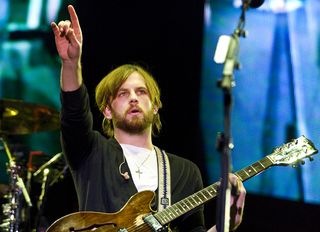
The End
So much for starting with the obvious. Cavernous drums, booming bass and an eerie, squiggly guitar line are quickly overtaken by a dramatic, Telstar 2010 synth (to be repeated throughout). Creepy, jarring, and yet we’re drawn in like moths to a flame.
The verse is built around a sparse bass and drum pattern with Caleb singing like he‘s God‘s lonely man, forgotten but not gone. While he still sounds like Tom Petty with a mouthful of Big League Chew, he’s a captivating, multi-dimensional vocalist whose emotions leap from his throat as if he’s been electrically prodded.
The chorus is a barrage, with watery guitars dropping from the sky and serving as a call-and-response to the surging Eno-esque flourishes that ultimately envelope the song. “I ain’t got a home,” Caleb cries again and again, with such penetrating force that you actually believe him.
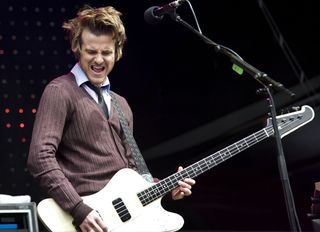
Radioactive
Here’s a crazy first single. Jared Followill’s fuzzed-up, zooming bass kick-starts this groove-filled number, over which cousin Matthew Followill adds a swirling top-string riff.
While bass playing dominates the verses - Jared drives the rhythm so violently that he sounds like a helicopter hovering overhead - the whole band gangbangs the chorus, with cymbals crashing, guitars zipping every which way and Caleb growling in all his ragged glory about sin and redemption over the din.
A dash of a gospel choir can be heard towards the end, and while it might be a subtle nod to their sons-of-a-preacher-man roots, it’s not as cheesy (or as obvious) as it sounds.
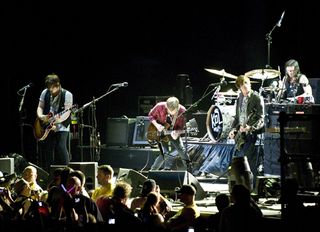
Pyro
After an enchanting, slippery guitar arpeggio (heard again in the choruses), the rhythm section provides a loping yet solid foundation over which Caleb paints a reflective, intricately detailed portrait of misspent years.
While the melody and song structure aren’t fully formed by traditional standards - playing-wise, the track is an experiment in restraint - the muted desperation in Caleb’s voice is what makes Pyro truly catch fire.

Mary
Now, here‘s a real surprise! This standout cut will have you think that the Followill boys took a dip in a hot tub time machine and raided the Brill Building’s vault of an unrecorded Carole King or Paul Anka gem. Or maybe even earlier - it’s got an unmistakable Everly Brothers vibe, too, with a pinch of doo-wop thrown in for good measure.
Simply delightful from the word go, this grunged-up nod to early late ‘50s/early ‘60s pop is loaded with Wall Of Sound backing vocals and a Wrecking Crew instrumental attack that would make Phil Spector green with envy.
Matthew uncorks a corker of a scratchy guitar solo, but it’s Caleb who commands the spotlight. With a lump in his throat and an ache in his chest, he pleads eternal love to Mary - if she’s real, she’ll be sobbing in her pillow - in this modern-day teenage symphony to God.
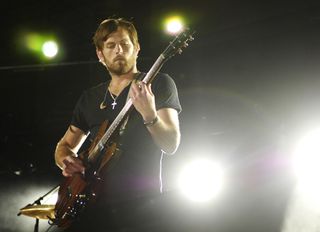
The Face
Piercing, rippling guitars, walloping snare cracks and a stark yet evocative bassline inform this midnight ride into the darkest of dreams.
Caleb’s vocals are all sandpaper and dust - he rasps like a man who’s just crawled across the desert and needs a drink of anything fast - but that only adds to his personal melodrama.
A quivering guitar break in the midsection builds to a power keg of a final chorus. Make no mistake, this is an abstract mood piece - melodically, it’s not likely to be covered on American Idol - but it’s one that’s bound to get under your skin.
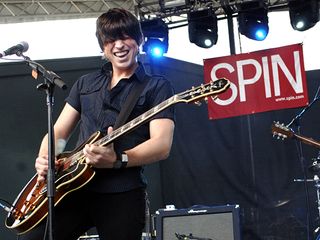
The Immortals
Another ‘WTF is this?’ that still manages to cast a spell. After a grinding groove peppered by echoey guitar jabs, the tempo shifts abruptly, slowing down to a steady rush of rhythmic waves which make up body of the chorus.
With every sea change, and The Immortals takes several quirky turns, Matthew comes into his own, peeling off goosebumps-raising guitar patterns that quake through the mix like Sensurround.
While he may not be the audio scientist that The Edge is, he’s gaining on him. Matthew has quickly become KOL’s secret weapon, developing a multi-faceted tonal personality that can drive any song, no matter how unformed, into a land of hypnotic splendor.
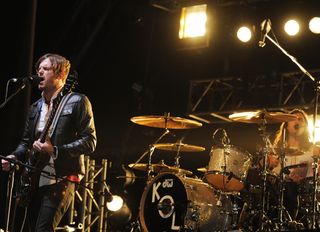
Back Down South
Twangy guitars (Dobros?) and a verse that recalls Mellencamp’s Pink Houses make it appear that KOL, however briefly, have caught sight of the Nashville skyline in their rear view mirrors.
A sweeping country fiddle and slide guitars play off one another as the tempo, accented by handclaps, gathers steam. It’s as close to a barn dance as the band is likely to get (Caleb’s Southern accent is most pronounced), and it’s a little off-kilter, too, as if the glow of moonshine was all too much for the guys (although, let’s be honest, they can afford the good stuff now).
Historically, Back Down South feels a little backwards, coming off as homage to Exile On Main St (on which The Stones gave props to American roots music). Even while playing it straight, the Followill boys don’t exactly walk the line.

Beach Side
From Nathan’s opening snare roll, this is an affecting head-turner, with a snappy tempo and an arpeggiated guitar pattern that would suggest the Followills have a few Style Council albums in their collections. (And maybe throw some Jam in there, too - Jared’s simple yet potent bass licks have a decidedly Foxtonian punch.)
Jazzy guitars and light, breezy drumming are in bold contrast to Caleb’s pensive vocals, as he ruminates on loves gone by.
Despite its title, this is no Beach Boys fun, fun, fun in the sun romp; in fact, it’s a shape-shifter: In the ride-out, Nathan swings briskly on the ride cymbal (accentuated by an overdubbed tambourine), but the mood turns increasingly dark, leaving one with the sad image of Caleb, alone in the attic, staring longingly at books of faded photographs.

No Money
A chiming guitar sits neatly behind a gnarly riff, but it doesn’t take long for Jared and Nathan to make a thunderous entrance. All at once, we’re galloping away on what is the fastest track on the album.
With power chords rising and falling and the rousing hum of amps all around, Nathan accents the verses with nimble hi-hat splashes. A zonked-out guitar solo, squealing like a pig, bursts through amidst the ‘whoo-hoo’ background vocals. Meanwhile, the band keeps cookin’ with wild abandon.
Caleb’s vocals are tucked in the back of the mix - they have a bit of a first-pass quality - making it nearly impossible to understand what he’s singing. But as a no-nonsense rocker, it gets the job done.

Pony Up
KOL get funky? Yep, in a vague Talking Heads/Tom Tom Club sort of way. Which means give it up for the rhythm section, as Jared’s distorted, playful bass and Nathan’s syncopated drumming (complete with cowbell) will provide for countless dance remixes.
Matthew adds splashes of haywire guitar throughout, but he leaves plenty of space for the groove. In fact, everything he plays enhances the song and pushes the agenda forward. Shrewd as the day is long, he never showboats.
The track is a quickie, over in just three minutes (as the album progresses, the numbers get noticeably shorter, and freakier). Call Pony Up a fun jam, an amusing trifle.

Birthday
Whether scratchy or clean, jangly or rippling with distortion, the trick bag of Followill guitar tones appears bottomless. Birthday starts with an sugary, chimey pattern that is enhanced by what sounds like distant miking - one can really hear the room’s acoustics.
The verse has a understated soulful feel, with Caleb singing curious rhymes like “Your come-on legs and your pantyhose/ you look so precious with your bloody nose.” How’s that for an image? Still, he sounds almost chipper - guess he likes birthdays.
The band pumps up the intensity for the choruses, particularly the end in which Matthew sparks up a rapid-fire top-string revelry that brings the song to a stunning conclusion.

Mi Amigo
What begins like a dusty Pearl Jam-inspired ballad turns on its head into a chugging, tightly wrought, mid-tempo rocker. Over wet, snapping, distorted chords Caleb sings, “I’ve got a friend/ shows me all the good times/ tells me when I’ve been better/ chews me up and spits me out/ and then watch my eyes hold/ he sings a song when I’m gone…gone…gone…”
The backbone of the song rests in the two strongest elements in KOL’s arsenal: Caleb’s fabulously expressive voice and Matthew’s unyielding ability to coax absorbing guitar nuances out of riffs and figures from what might be ordinary in other players’ hands.
The chorus is relatively undefined, but as a pastiche of hodgepodge ideas and styles, shadows and lights, it’s an arresting listen.

Pickup Truck
As a closing track, one could call this Kings Of Leon’s Love Is Blindness and not be wrong. A guided tour into the fog of the unknown, it sounds as if one is hearing it at the moment of inception.
Matthew’s E-Bowed guitar rises like a cobra amidst minimalist bass and the clitter-clack of side-stick drumming. With a lilting guitar filling in the holes, Caleb sings a poem of sorrow and regret. He’s downtrodden, smashed to pieces, and his woeful yelp might just leave you devastated.
The song, like many in the KOL canon, follows the reverse blueprint set by the Pixies (and later adopted by Nirvana) of quietLOUDquiet. It’s a brilliant rock ‘n’ roll device, and one that Kings Of Leon use to wondrous effect.
As has been the case through the entire album, Matthew’s sterling guitar work is the centerpiece. During a breathtaking breakdown section, he plays an echo-drenched pattern that becomes a motif, one which he carries right on through to the final shattering chorus.
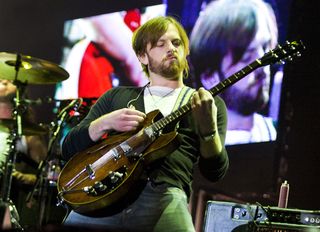
Verdict
In a pre-release interview, drummer Nathan Followill described Come Around Sundown as being “fun” and “beach-y.” (Goof on the press much, Nathan?) While the new album isn’t bound to inspire dreams of hanging 10 and clambakes, it certainly is fun - that is, if your idea of a good time is a record that is by turns challenging, soothing, difficult to categorize and thrilling from its opening seconds.
This might come as sad news for those who still pine for the chicken-fried days of Holy Roller Novocaine, of unkempt hair and moustaches and bluesy, vaguely Black Crowes garage jams.
On the other hand, it will provide prompt, sweet succor for the millions who revel in what the group has become, that rare and beautiful thing in art: a band that writes and breaks their own rules as they go along, one that now exists with little to no antecedent, with a sound and spirit as unique as inexplicable as the sun.
On Come Around Sundown, Kings Of Leon deliver soulful ache and a whirlpool of purposeful, spacey noise that demand nothing of the listener but to dive in and be cleansed.
Liked this? Then check out Kings Of Leon on MusicRadar: video lessons, audio interviews, stage gear and more.
Connect with MusicRadar: via Twitter, Facebook and YouTube
Get MusicRadar straight to your inbox: Sign up for the free weekly newsletter

Joe is a freelance journalist who has, over the past few decades, interviewed hundreds of guitarists for Guitar World, Guitar Player, MusicRadar and Classic Rock. He is also a former editor of Guitar World, contributing writer for Guitar Aficionado and VP of A&R for Island Records. He’s an enthusiastic guitarist, but he’s nowhere near the likes of the people he interviews. Surprisingly, his skills are more suited to the drums. If you need a drummer for your Beatles tribute band, look him up.
